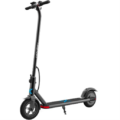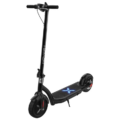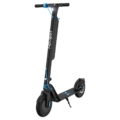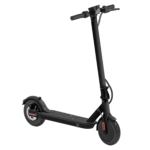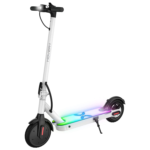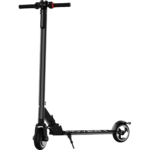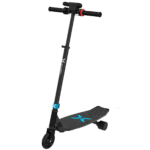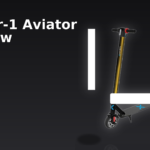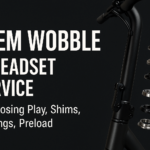- Home
- Scooters
- Electric Scooters
- Hover-1 Escape
Hover-1 Escape
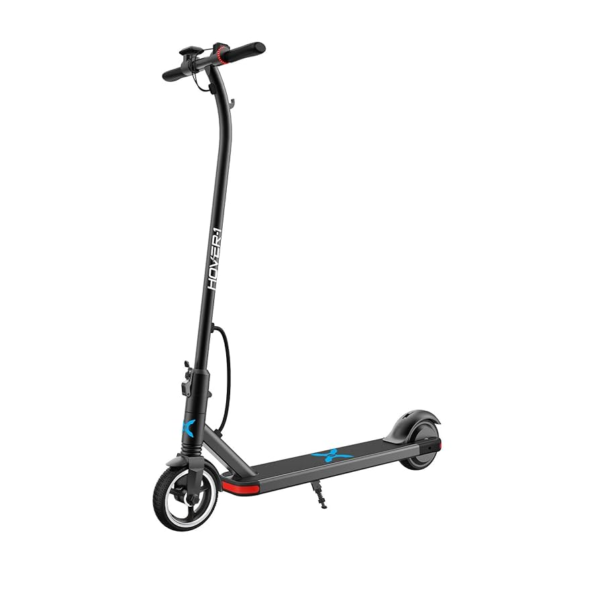

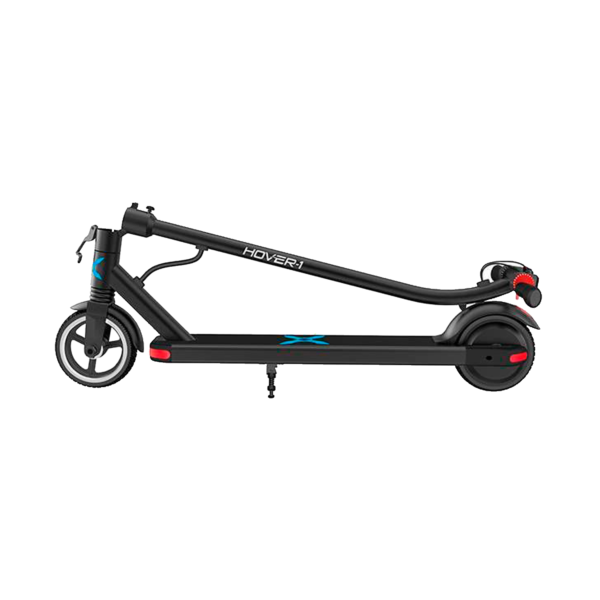
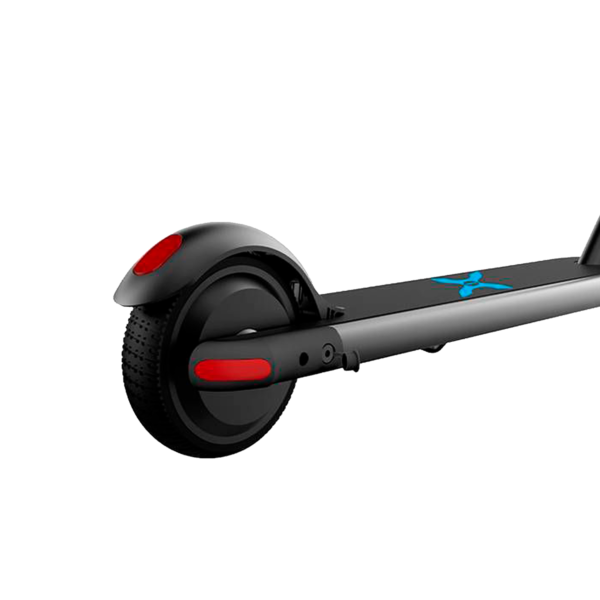
- Battery Range: 9 miles (14 km)
- Top Speed: 16 mph (26 km/h)
- Motor Power: 250 W
- Weight Capacity: 264 lb (120 kg)
- Charging Time: Not specified
- Scooter Weight: 23.3 lb (10.6 kg)
PROS
- Light 23.3 lb portable frame
- Up to 16 mph top speed
- Up to 9-mile urban range
- Solid 6.5″ tires (no flats)
- Folding design
- 264 lb max rider load
CONS
- Short range for commuting
- No suspension
- Small 6.5″ wheels
- Basic electronic + foot braking

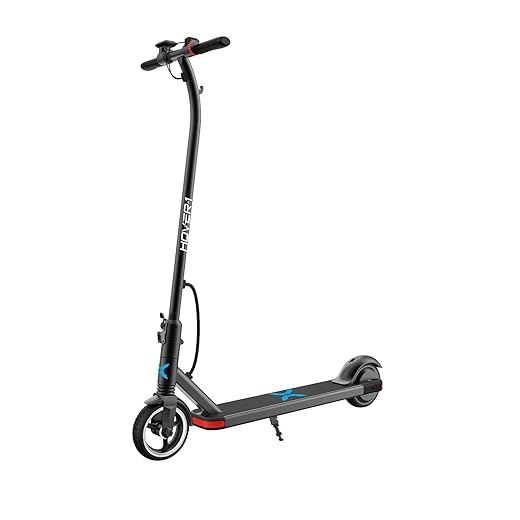
Table of contents
- What Is the Hover-1 Escape?
- How the Hover-1 Escape Works
- Key Specifications (clean table)
- Design & Build Quality
- Performance Fundamentals
- Battery, Range & Efficiency
- Ride Quality & Comfort
- Braking & Safety Features
- Portability & Daily Usability
- Maintenance & Care
- Weather & Seasonal Considerations
- Hover-1 Escape vs Alternatives
- Who the Hover-1 Escape Is (and Isn’t) For
- FAQs
- Glossary
- Final Notes on Using the Official Specifications
If you want a simple, compact, and low-maintenance commuter scooter for short trips, the Hover-1 Escape sits right in that “easy to live with” sweet spot. It focuses on essentials: modest power, a practical top speed, and solid tires that shrug off flats. Beginners appreciate how approachable it feels, while experienced riders often keep it as a grab-and-go last-mile vehicle for quick errands or campus rides.
The Hover-1 Escape emphasizes light weight, straightforward controls, and an uncomplicated folding design. It won’t set speed records, yet it helps you replace short car rides with something more nimble and fun. This overview explains what it is, how it works, and how to get the best from it—so you can decide whether it fits your daily routine.
What Is the Hover-1 Escape?
The Hover-1 Escape is a compact, folding electric scooter designed for short-range urban travel. It uses a 250-watt brushless front hub motor and a 36-volt battery to reach a rated top speed of up to 16 mph (26 km/h). Range is rated up to 9 miles (15 km), which covers neighborhood commutes, quick grocery runs, and most last-mile connections. It weighs about 23.25 lb (10.55 kg), so it’s manageable to carry up a flight of stairs or into public transport.
Instead of air-filled tires, the Escape uses 6.5-inch solid rubber tires. As a result, you don’t need to monitor tire pressure or worry about punctures. The trade-off is a firmer ride on rough pavement. Braking is split between an electronic system and a mechanical brake, giving you a predictable way to scrub speed while keeping maintenance simple.
A small LCD in the cockpit shows your speed, battery level, riding mode (speed level), and trip data. The folding mechanism uses a straightforward latch, and the footprint when folded fits easily in closets, office corners, or the trunk of a compact car. All told, the Escape aims to be an uncomplicated, low-overhead way to move around town.
How the Hover-1 Escape Works
At its core, the Escape combines five key systems working together:
Motor (front hub, brushless, 250 W). A brushless DC motor is built into the front wheel hub. When you press the thumb throttle, the controller meters current to the motor. Brushless designs reduce friction and improve reliability because there are no brushes to wear out.
Controller. The controller is the scooter’s “brain.” It monitors throttle input, battery voltage, and speed level, then sends power to the motor accordingly. It also handles the electronic braking function, cutting power and applying motor resistance when you engage the brake lever or electronic brake.
Battery (36 V, 5.0 Ah). The lithium-ion battery stores energy for the motor and display. It is built into the chassis for simplicity and protection. Charge time is rated up to three hours using the included charger.
Throttle. A thumb throttle on the right side of the handlebar signals how much power you want. The Escape provides three speed levels, allowing you to select gentler acceleration and lower top speed or bump it up when you have more room to ride.
Brakes (electronic + mechanical). The electronic system delivers smooth deceleration by using the motor as a retarder, while the mechanical brake adds stopping power and a familiar lever feel. This combination helps newer riders develop consistent braking habits.
Think of the system like a compact hybrid between a bicycle and a small EV. The throttle replaces pedaling, the controller acts like cruise electronics (without true cruise control), and the motor provides smooth, quiet thrust. The brake lever engages both electronic resistance and a mechanical friction brake so you can modulate stops in a controlled way.
Key Specifications (clean table)
All values below mirror the official operation manual; U.S. and metric figures are shown side-by-side.
| Category | Item | Details |
|---|---|---|
| General | Model | H1-ESC |
| Net Weight | 23.25 lb (10.55 kg) | |
| Max Supported Weight | 264 lb (120 kg) | |
| Min Supported Weight | 44 lb (20 kg) | |
| Performance & Power | Top Speed | Up to 16 mph (26 km/h) |
| Motor | 250 W brushless front hub | |
| Battery, Charging & Electrical | Battery | 36 V, 5.0 Ah (≈ 180 Wh) |
| Charge Time | Up to 3 hours | |
| Charger Input (AC) | 100–240 V, 50/60 Hz | |
| Display | LCD with speed, battery, trip, speed level controls | |
| Build & Dimensions | Tires | 6.5-inch solid (front & rear) |
| Open Size (L×W×H) | 38.54 × 15.9 × 44.2 in (97.9 × 40.4 × 112.3 cm) | |
| Folded Size (L×W×H) | 39.37 × 15.75 × 15.75 in (100 × 40 × 40 cm) | |
| Safety & Control | Brakes | Electronic + mechanical |
| Lighting | Front LED light (reflectors not equipped) | |
| IP Rating | Not specified; avoid water exposure | |
| Features & Extras | Riding Modes | 3 speed levels via (+/–) buttons |
| Cruise Control | Not specified | |
| Warranty & Compliance | Warranty | Limited, per manufacturer policy |
| Compliance | FCC Part 15 |
Design & Build Quality
The Escape’s build favors simplicity and low upkeep. The aluminum frame keeps weight down while providing a sturdy stem and deck. Because the battery is integrated into the chassis, the exterior stays tidy and durable. The deck is long enough for a comfortable stance with one foot ahead of the other, while the rubberized surface improves grip when it’s dusty or slightly damp.
Cable routing is straightforward. That makes inspection and occasional adjustments easier for new riders. The folding system is a practical latch with a firm detent, and it resists wobble well when properly locked. The handlebar layout is clean, too. The LCD sits central with clear battery and speed readouts. The throttle and brake are spaced so your hands find them naturally, even with gloves.
Fit-and-finish reflects its entry-level mission. You get solid tires that eliminate flats and pressure checks. You also get a basic kickstand and a front LED for dusk rides. However, because the scooter is not equipped with reflectors, you should add reflective gear to your clothing or helmet for low-light visibility.
Performance Fundamentals
Acceleration is modest but predictable. In the lowest speed level, take-offs feel gentle. That’s good for beginners and crowded paths. The second speed level is where many riders spend most of their time. It gives enough punch to keep up with neighborhood traffic without feeling twitchy. In the highest level, the Escape works up to its rated 16 mph (26 km/h) on flat ground with a sensible run-up.
Stability improves when your weight is balanced between the wheels. Because the motor is in the front hub, the scooter pulls rather than pushes. Keep your knees slightly bent and your torso relaxed; you’ll feel the front end track cleanly. At speed, the small wheels reward smooth steering inputs and early braking. Consequently, you avoid mid-corner corrections that can unsettle the chassis.
Hill-climb behavior is typical for a 250-watt scooter. On longer grades around 7–10%, plan on a lighter pace. It helps to carry momentum before the incline and choose the top speed level at the base. If the hill is steep and slow, a brief kick assist will support the motor and maintain balance. With practice, you’ll learn that early throttle, steady stance, and small steering inputs keep the scooter composed on mild climbs.
Battery, Range & Efficiency
The Escape’s 36-volt, 5.0 Ah pack stores roughly 180 Wh of energy. In easy conditions—flat paths, warm weather, and smooth riding—the scooter can approach its rated “up to 9 miles (15 km)” claim. However, real routes vary. Headwinds, colder temperatures, rolling hills, frequent stops, and heavier riders all draw power faster. Therefore, treat the rated figure as an upper bound under ideal conditions.
Charging is simple. The included charger connects to the charging port on the deck, and a full charge from low typically takes up to three hours. For best lithium-ion health, avoid deep discharges as a routine. Instead, top up after rides when convenient, and store the scooter around room temperature. During long storage, leaving the battery partially charged (not empty) and recharging it periodically helps preserve capacity over time. Respect the listed safe working and charging temperature ranges to protect the pack.
Efficiency improves when you ride smoothly. Maintain a steady pace in speed level 2 unless you need the extra headroom of level 3. Coast early toward intersections. Keep your stance aerodynamic by relaxing your shoulders. Because solid tires can transmit small vibrations, choose cleaner lines around rough patches. Each of these small habits reduces energy spikes that waste battery.
Ride Quality & Comfort
Solid 6.5-inch tires define the Escape’s feel. The upside is no flats, no pump, and no messy sealant. The downside is less cushioning on cracked pavement. You’ll feel expansion joints, driveway lips, and sharp seams more than you would with larger pneumatic tires. Fortunately, rider technique helps. Bend your knees slightly. Keep your arms relaxed rather than locked. Float your weight over bumps and lift slightly over curbs you must roll.
The deck height and bar reach suit average-height adults and teens. Since bar height is fixed, taller riders may prefer a slightly staggered stance to lower their torso and reduce wind drag. Grip texture is practical. Furthermore, the scooter doesn’t suffer from excessive stem flex when the latch is properly closed, which sustains confidence on smooth straightaways.
Noise levels remain low. The brushless motor hum is faint, and the solid tires produce a consistent “whirr” on smooth concrete. On rough asphalt, expect more tire noise, though it stays within normal scooter sounds. As a result, the Escape feels composed on typical neighborhood surfaces.
Braking & Safety Features
The Escape blends electronic and mechanical braking. The electronic system initiates quickly when you ease off the throttle and squeeze the lever. It provides controlled drag through the motor so you can fine-tune speed without abrupt grabs. The mechanical brake adds bite when you need a shorter stop or you’re descending a hill. Practice combining both gently at first. You’ll learn where the electronic brake starts to slow the wheel and how much lever pull brings the mechanical system in firmly. For a deeper primer on how regenerative braking works in everyday riding, see Regen Braking: Types, Limits & Battery Impact.
Lighting includes a front LED. That helps others see you at dusk, and it adds a pool of light at walking speeds. However, because reflectors are not supplied, you should upgrade your visibility with reflective clothing or an accessory clip-on reflector if local rules allow. Always ride defensively around parked cars, driveways, and intersections. Keep in mind that water exposure should be avoided; traction and electronics both become vulnerable when conditions are wet.
An official IP rating is not specified. Treat the scooter as fair-weather equipment. Dry the deck and folding hardware if you encounter mist or sprinklers. Above all, store the scooter indoors to protect bearings and the battery.
Portability & Daily Usability
Portability is a strong suit. At roughly 23.25 lb (10.55 kg), most riders can lift the Escape with one hand. The folded footprint—about 39.37 × 15.75 × 15.75 in (100 × 40 × 40 cm)—slides beside a desk or a hallway wall without taking over your space. The latch is intuitive once you’ve practiced, and the scooter is light enough to carry up a few flights without a struggle.
For errands, plan simple locking habits. While the battery is integrated and the scooter is compact, you should still bring it indoors whenever possible. If you must leave it outside briefly, choose a visible location and lock through the frame, not just a wheel. Avoid locking near sprinklers or puddles.
As a last-mile tool, the Escape pairs well with buses and trains thanks to its size. You can stand it upright in vestibules or tuck it under a seat in some cars. If your commute involves multiple transfers, the light weight reduces fatigue when walking between platforms.
Maintenance & Care
Although the Escape is low maintenance, a light routine keeps it riding well:
- Before each ride: Check that the folding latch is fully locked. Squeeze the brake to feel for firm engagement. Glance at the tire surfaces for embedded debris.
- Weekly: Wipe dust from the deck, bars, and display. Confirm brake function and lever travel. Inspect the charger cable for nicks.
- Monthly: Hand-check all visible fasteners for snugness. Verify the latch’s hardware is tight, then test-fold and re-lock. Review the charge port cap for a secure seal.
- Battery habits: Avoid full discharges. Top up when convenient. During long storage, keep the battery partially charged and recharge periodically. Follow the recommended charging and working temperature ranges.
Because the tires are solid, you won’t be topping up air. That removes a common chore found on pneumatic scooters. If the mechanical brake feel changes over time, a simple cable adjustment restores lever travel. Keep a basic multi-tool on hand for these checks.
Weather & Seasonal Considerations
Temperature and moisture have meaningful effects. In cold weather, lithium-ion batteries provide less output. As temperature drops, expect softer acceleration and shorter riding time. Warm weather restores performance, but you should still avoid leaving the scooter in direct sun for extended periods. Since water exposure is discouraged, riding in rain or through puddles can harm electronics and reduce traction. Consequently, keep rides dry and store the scooter in a ventilated indoor space after use.
On dusty summer paths, clean the deck and hinge area more frequently. Dust can accumulate near moving parts, and a quick wipe prevents gritty feel at the latch. In winter, wipe any road salt from metal hardware to avoid corrosion.
Hover-1 Escape vs Alternatives
Within the broader scooter landscape, the Escape falls into the light, short-range commuter class. Compared with performance scooters, it trades higher top speed and big batteries for weight savings and simplicity. Against off-road models, it has smaller, solid tires and no suspension, yet it’s easier to carry and store. Versus heavier commuters with larger pneumatic tires, it offers fewer comfort features but wins on maintenance and portability.
Choose the Hover-1 Escape when you care more about light weight, basic speed, and low-upkeep tires than about long-distance comfort. If your route is smooth, flat, and under 5–7 miles one way with the option to charge at your destination, this scooter’s format fits well. If your needs demand higher speeds, longer range, big hills, or frequent rough pavement, a larger commuter class with pneumatic tires and more wattage will serve you better.
Who the Hover-1 Escape Is (and Isn’t) For
Great for:
- Students and campus riders. It’s compact, easy to fold, and light enough for stairs.
- Last-mile commuters. It slots neatly into public transit routines and short urban hops.
- New riders. The smooth throttle, modest acceleration, and clear display are beginner-friendly.
- Apartment dwellers. The folded size and integrated battery make indoor storage simple.
- Low-maintenance seekers. Solid tires eliminate flats and pressure checks.
Consider something else if:
- Your commute demands long range at higher speeds.
- You face steep hills daily and want strong climbing torque.
- You need suspension and large pneumatic tires for rough streets.
- You plan to ride in wet weather despite the lack of a stated IP rating.
The Hover-1 Escape offers a clear value proposition: easy daily mobility with minimal fuss. If that matches your pattern, it’s a sensible pick.
FAQs
1) How fast does the Hover-1 Escape go?
It’s rated for up to 16 mph (26 km/h) on flat ground in the highest speed level. Always ride within your skill and local rules.
2) How far can it travel on one charge?
Under ideal conditions, the Escape is rated up to 9 miles (15 km). Real-world range varies with rider weight, speed, terrain, stops, and temperature.
3) Does it have cruise control?
The documentation does not list cruise control. It does provide three speed levels you can select from the cockpit.
4) What’s included in the Hover-1 Escape overview?
This “Hover-1 Escape overview” explains the scooter’s components, riding behavior, battery care, and the official spec highlights, plus practical guidance on comfort, safety, and maintenance.
5) Is it water-resistant?
An official IP rating is not specified. Avoid water exposure and riding in wet conditions.
6) What kind of tires and brakes does it use?
It rolls on 6.5-inch solid tires and combines electronic and mechanical brakes for everyday stopping power.
7) How long does it take to charge?
Charge time is up to three hours with the included charger, depending on starting level and conditions.
Glossary
- Ah (Ampere-hour): A measure of battery capacity. Higher Ah stores more charge.
- Wh (Watt-hour): Voltage × amp-hours; an energy measure that helps estimate potential range.
- Brushless Motor: An efficient electric motor with electronic commutation and no brushes to wear.
- Controller: The electronic module that regulates power flow from battery to motor and manages inputs.
- Thumb Throttle: A lever at the handlebar that signals how much power you want.
- Regen/Electronic Braking: Motor-based braking that resists wheel rotation electronically.
- Mechanical Brake: A physical friction system that adds stopping force at the wheel.
- Speed Levels (Modes): Preset limits for acceleration and top speed to match conditions.
- Stem Flex: The degree the handlebar stem bends under load; too much harms steering precision.
- Deck: The platform you stand on; its size and grip affect comfort and control.
- IP Rating: A standardized water/dust ingress rating. Not specified on the Escape; avoid water.
- Solid Tires: Rubber tires without air; they prevent flats but ride firmer on rough surfaces.
- Pneumatic Tires: Air-filled tires that cushion bumps but require pressure checks and can get flats.
- Grade (Hill): The steepness of an incline, often expressed as a percentage.
- FCC Part 15: U.S. compliance standard for radio-frequency devices.
Final Notes on Using the Official Specifications
The Key Specifications section summarizes the official numbers for top speed, range, weight, dimensions, battery, and braking system. Display features and speed-level controls are also captured from the documentation, and battery charge time and temperature guidance appear in its battery care section.
Specifications
General
| Model The Model specifies the exact version or name of the scooter. It helps identify its unique design, features, and specifications within the manufacturer’s product line. Knowing the model makes it easier to compare options, find compatible accessories, or look up support information. | Escape |
| Brand The Brand identifies the manufacturer or company that designs and produces the scooter. A trusted brand is a sign of quality, reliability, and good customer support. Well-known brands often have higher standards for safety, performance, and after-sales service, giving you more confidence in your purchase. | Hover-1 |
| Release Date The Release Date indicates when the scooter model was officially launched on the market. This helps you know how current the design, technology, and features are. A newer release date often means updated components, improved performance, and the latest safety or smart features. | 17 November 2025 |
| Recommended Age Recommended Age indicates the minimum age range that the scooter is designed for, based on safety, size, and ease of use. Following the recommended age helps ensure that riders can handle the scooter’s speed, weight, and controls comfortably and safely. Always check local laws and use protective gear, especially for younger riders. | +16 |
Performance & Power
| Motor Power (Wattage) What it means: The motor power, measured in watts (W), shows how strong the scooter’s electric motor is. Why it matters: Higher wattage usually means better acceleration, more torque, and improved performance on hills or rough terrain. For example, a 250W motor is good for flat city roads and light riders, while a 500W or 1000W motor provides more power for faster speeds or climbing steep inclines. | 250 W brushless motor |
| Top Speed The Top Speed indicates the maximum speed that the scooter can reach under optimal conditions. It’s usually measured on level ground with a fully charged battery and an average rider weight. A higher top speed allows you to travel longer distances faster, but always ensure you ride within legal speed limits and your personal comfort zone for safety. | Up to 16 mph (26 km/h) |
| Battery Capacity Battery Capacity refers to the total amount of energy the scooter’s battery can store, usually measured in ampere-hours (Ah) or watt-hours (Wh). A higher battery capacity means you can ride longer distances on a single charge, reducing the need for frequent recharging. Keep in mind that actual range can vary depending on rider weight, terrain, speed, and weather conditions. | Not specified |
| Estimated Range per Charge The Estimated Range per Charge indicates the average distance the scooter can travel on a single full battery charge. This range is calculated under optimal conditions, such as flat terrain, moderate speed, and average rider weight. Real-world range may vary depending on riding style, terrain, weather, and load. A longer range means fewer recharges and greater freedom for longer trips. | Up to 9 miles (14 km) |
| Hill Climb Ability Hill Climb Ability describes the maximum incline or slope that the scooter can handle while maintaining stable performance. It’s typically expressed as a percentage or in degrees. A higher hill climb rating means the scooter can tackle steeper hills without losing too much speed or power. Actual climbing performance may vary based on rider weight, battery charge, and terrain conditions. | Not specified |
| Drive System The Drive System refers to how power from the motor is delivered to the wheels. Electric scooters typically use either a hub motor (directly integrated into the wheel) or a chain/belt drive system. A high-quality drive system ensures smooth acceleration, efficient power transfer, and low maintenance. The choice of drive system affects performance, noise level, and overall ride experience. | Not specified |
Charging & Electrical
| Charging Time Charging Time indicates how long it takes to fully recharge the scooter’s battery from empty to 100% using the standard charger provided. Faster charging means less downtime and more time on the road. Actual charging time may vary slightly depending on battery capacity, charger output, and environmental conditions. | Not specified |
| Battery Type Battery Type refers to the specific technology used in the scooter’s battery, which affects performance, lifespan, weight, and charging time. Most modern electric scooters use high-quality lithium-ion (Li-ion) batteries because they offer a good balance of energy density, durability, and low maintenance. A reliable battery type ensures consistent power delivery and longer riding ranges. | Lithium-ion battery |
| Removable Battery A Removable Battery means the battery pack can be easily detached from the scooter for convenient charging and replacement. This feature allows you to charge the battery separately, swap it with a spare for extended range, or securely store it indoors in extreme weather. Removable batteries add flexibility and make it easier to keep your scooter powered up wherever you are. | Non-removable internal battery |
| Regenerative Braking Regenerative Braking is an energy-saving feature that converts some of the energy normally lost during braking back into battery power. When you slow down or brake, the motor works in reverse to generate electricity, which helps extend the scooter’s range and improves overall efficiency. This system also reduces wear on traditional brake components, leading to lower maintenance over time. | Yes (via electronic brake) |
| Lighting Lighting refers to the built-in front and rear lights that enhance visibility and safety when riding in low-light conditions or at night. Good lighting helps you see the road ahead and ensures that other road users can see you. Many scooters include LED headlights, taillights, and sometimes brake lights or side reflectors for added safety and compliance with local traffic regulations. | Not specified |
Build & Dimensions
| Scooter Weight Scooter Weight refers to the total weight of the scooter when fully assembled, including the battery. This affects how easy it is to carry, lift, and store the scooter when not in use. A lighter scooter is more portable and convenient for commuting, especially if you need to carry it upstairs or onto public transport. Keep in mind that a sturdy frame and quality components may add to the weight but also contribute to better durability and ride stability. | 23.3 lb (10.6 kg) |
| Maximum Rider Weight Maximum Rider Weight indicates the highest rider weight that the scooter is designed to safely support while maintaining optimal performance and stability. Staying within this limit helps ensure reliable acceleration, braking, and climbing ability, and it protects the frame, suspension, and motor from excessive strain. Exceeding the recommended limit may reduce performance and increase wear on components. | 264 lb (120 kg) |
| Deck Size Deck Size refers to the dimensions of the scooter’s standing platform. A wider and longer deck provides more foot space, allowing you to stand comfortably and adjust your stance while riding. A well-sized deck improves balance and stability, especially on longer rides or at higher speeds. Compact decks, on the other hand, help keep the scooter lightweight and portable. | Not specified |
| Handlebar Height Handlebar Height refers to the distance from the deck to the handlebars, which affects your riding posture and comfort. An appropriate handlebar height helps you maintain good balance, reduces strain on your back and arms, and makes steering more comfortable. Some scooters have adjustable handlebars to fit riders of different heights, while others have a fixed height for a streamlined design. | Fixed |
| Folding Mechanism The Folding Mechanism describes how easily and securely the scooter can be folded for carrying and storage. A well-designed folding system lets you quickly collapse the scooter into a compact size, making it convenient to transport on public transit, store under a desk, or fit into a car trunk. Look for sturdy latches and safety locks to ensure the scooter stays firmly in place when folded or unfolded. | Folding latch |
| Dimensions Folded Dimensions indicate the size of the scooter when it’s fully folded. This measurement shows how much space the scooter will take up when stored or carried, making it easier to check if it will fit in your car trunk, under a desk, or in a closet. Compact folded dimensions are ideal for commuters who need to bring their scooter on public transport or store it in tight spaces. | Not specified |
| Material Material refers to the primary construction materials used for the scooter’s frame and key components. High-quality materials like aircraft-grade aluminum, reinforced steel, or durable composites provide strength, stability, and a lighter overall weight. A sturdy material ensures the scooter can handle daily wear and tear while maintaining safety and performance. | Not specified |
Safety & Control
| Brake Type(s) Brake Type(s) describe the braking systems the scooter uses to help you slow down or stop safely. Common brake types include mechanical brakes (like drum or disc brakes), electronic brakes, and foot brakes. Many scooters combine multiple braking systems for added safety and shorter stopping distances. The type and quality of brakes affect your control, especially when riding at higher speeds or on slopes. | Electronic brake + rear foot brake |
| Suspension Suspension refers to the system that absorbs shocks and vibrations while riding, providing a smoother and more comfortable ride over uneven or rough surfaces. Scooters may have front suspension, rear suspension, or dual suspension for better shock absorption and stability. Good suspension helps reduce rider fatigue and improves control, especially when riding on bumpy roads or off-road paths. | None |
| Tire Type Tire Type refers to the kind of tires the scooter uses, which directly affects ride comfort, traction, and maintenance. Common types include solid (airless) tires, pneumatic (air-filled) tires, or hybrid options. Pneumatic tires offer better shock absorption and a smoother ride on rough surfaces, while solid tires are puncture-proof and require less upkeep. The right tire type helps ensure safe handling and a comfortable ride in different conditions. | Solid tires |
| Tire Size Tire Size indicates the diameter and width of the scooter’s tires, which affect ride comfort, stability, and how well the scooter handles different terrains. Larger tires generally offer better shock absorption and a smoother ride over bumps and rough surfaces, while smaller tires keep the scooter lighter and more portable. Choosing the right tire size helps ensure a balance between agility and comfort. | 6.5-inch |
| Kickstand The Kickstand is a built-in stand that allows you to park your scooter upright when it’s not in use. A sturdy kickstand keeps the scooter stable and prevents it from tipping over, protecting it from scratches and damage. It also makes storing and accessing your scooter more convenient, whether you’re at home, work, or on the go. | Not specified |
| Water Resistance Rating Water Resistance Rating indicates how well the scooter is protected against water and moisture, usually shown as an IP (Ingress Protection) rating. This rating helps you understand whether the scooter can handle light rain, splashes, or wet roads without damage. While most scooters are not fully waterproof, a good water resistance rating adds peace of mind when riding in changing weather conditions. Always avoid deep puddles or submerging the scooter to protect its electrical components. | Not specified |
Features & Extras
| Display/Console The Display (or Console) shows important real-time information about your ride, helping you monitor your scooter’s status at a glance. Typical displays show speed, battery level, distance traveled, and riding mode. Some models also include additional features like Bluetooth connectivity, app integration, or backlighting for better visibility at night. A clear and easy-to-read display enhances safety and convenience on every trip. | Not specified |
| Ride Modes Ride Modes refer to the different speed and power settings you can choose to match your riding style or road conditions. Common modes include eco for maximum range and energy efficiency, standard for everyday balance, and sport or turbo for higher speed and stronger acceleration. Switching between ride modes allows you to customize performance, conserve battery, and ride safely in various environments. | Not specified |
| Smart App Connectivity Smart App Connectivity lets you pair your scooter with a dedicated mobile app via Bluetooth. Using the app, you can monitor real-time ride stats like speed, battery level, and range, adjust settings such as ride modes or cruise control, lock the scooter for added security, and sometimes receive firmware updates. This feature adds convenience and allows you to personalize your riding experience right from your smartphone. | No app |
| Anti-Theft System The Anti-Theft System helps protect your scooter from unauthorized use or theft. This feature can include built-in alarms, electronic motor locks, GPS tracking, or remote locking through a mobile app. A good anti-theft system provides peace of mind when parking your scooter in public spaces, adding an extra layer of security to safeguard your investment. | Not specified |
| Cruise Control Cruise Control allows you to maintain a steady speed without continuously holding the throttle. This feature makes longer rides more comfortable by reducing hand fatigue and providing a smoother, more relaxed riding experience — especially on flat, open roads or bike lanes. For safety, cruise control can usually be easily activated or deactivated while riding. | Not specified |
| Accessories Included Accessories Included lists the additional items that come with the scooter to enhance your riding experience and convenience. Common accessories may include a charger, kickstand, bell, lights, phone holder, or carrying strap. These extras add value by making your scooter safer, easier to use, and ready to ride straight out of the box. | Scooter, charger, manual |
Warranty & Compliance
| Warranty Period The Warranty Period indicates how long the manufacturer guarantees the scooter against defects in materials and workmanship under normal use. A good warranty provides peace of mind, showing the brand’s confidence in its product quality. Always check what parts are covered, such as the frame, battery, and motor, and follow the maintenance guidelines to keep your warranty valid. | Region-dependent |
| Certifications Certifications confirm that the scooter meets specific safety, quality, and environmental standards set by recognized organizations or regulatory bodies. Common certifications may include CE, RoHS, UL, or other local compliance marks, depending on your region. These certifications ensure that the scooter is manufactured to high standards and is safe and legal to use in your country. | UL-listed charger; region-dependent compliance |
Price Comparison




